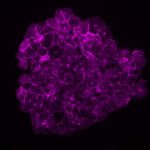Link to Pubmed [PMID] – 22721695
Link to DOI – 10.1016/j.molbiopara.2012.06.005
Mol Biochem Parasitol 2012 Sep; 185(1): 36-47
Chromosome ends have been implicated in the default silencing of clonally variant gene families in the human malaria parasite Plasmodium falciparum. These chromosome regions are organized into heterochromatin, as defined by the presence of a repressive histone H3 lysine 9 trimethylated marker and heterochromatin protein 1. Here, we show that the non-coding subtelomeric region adjacent to virulence genes forms facultative heterochromatin in a cell cycle-dependent manner. We demonstrate that telomere-associated repeat elements (TAREs) and telomeres are transcribed as long non-coding RNAs (lncRNAs) during schizogony. Northern blot assays revealed two classes of lncRNAs: a ~4-kb transcript composed of telomere sequences and a TARE-3 element, and a >6-kb transcript composed of 21-bp repeats from TARE-6. These lncRNAs are transcribed by RNA polymerase II as single-stranded molecules. RNA-FISH analysis showed that these lncRNAs form several nuclear foci during the schizont stage, whereas in the ring stage, they are located in a single perinuclear compartment that does not co-localize with any known nuclear subcompartment. Furthermore, the TARE-6 lncRNA is predicted to form a stable and repetitive hairpin structure that is able to bind histones. Consequently, the characterization of the molecular interactions of these lncRNAs with nuclear proteins may reveal novel modes of gene regulation and nuclear function in P. falciparum.


